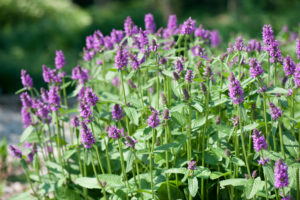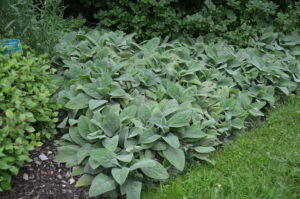Many gardeners are acquainted with the wooly leaf perennial called lambs ears (Stachys byzantina). But the genus Stachys is also home to betony (S. officinalis) / (S. monieri). Alpine betony (Stachys monieri) is native to Europe and Asia (USDA hardiness zones 4-8).
‘Hummelo’ betony is very different in appearance from its gray velvety leaf relative called lamb’s ears (e.g., Stachys byzantina). Instead of silvery foliage, Hummelo betony’s foliage is dark green and glabrous (hairless). In Southern climes the foliage is evergreen. This colorful and compact growing plant makes an excellent addition to the full sun perennial border. Wiry stems make for a great cut flower as well.
Hummelo exhibits an upright plant form @ 18 to 20 inches tall and wide. Pollinators can’t resist the striking lavender-rose flower spikes in late June thru July, emerging above basal glossy green foliage mounds. The bright flowers can be easily mistaken for salvias.
In comparison, lamb’s ear (S. byzantina) forms a dense mat of woolly silver-gray leaves. Plants grow 12 -15 inches high and 18 – 20 inches wide. Spikes of purplish pink flowers appear on tall stems in early summer that detract from the foliage and, in my opinion, should be pruned off. Bloom stalks often re-develop and necessitate more pruning. Seedlings from this weedy species will spread to other parts of the garden.
The cultivar ‘Countess Helene von Stein’, aka ‘Big Ears’, is the preferred choice among landscapers. It exhibits showier velvet (hairy silver) foliage, better heat and humidity tolerances, and best of all, it rarely flowers and seeds-in. Over time Big Ears develops a wider vegetative mound than the species.
Both types of Stachys are easily grown in moist well-drained soils and full to part day sun (6 hours or more recommended). Soils should be kept evenly moist, but established plants have some drought tolerance. Plants spread by underground stolons. Set multiple plants 12-18 inches apart as a ground cover. Feed in early spring at planting time with granular 10-10-10 or equivalent fertilizer.
No serious disease or insect pests trouble either species. Pollinators can’t resist the striking midsummer colorful floral spikes. Deer and rabbits generally stay away. Snails and slugs may be troublesome in wet summers.
The Perennial Plant Association has selected Stachys monieri ‘Hummelo’ as 2019 Perennial Plant of the Year.



 Posted in
Posted in 
